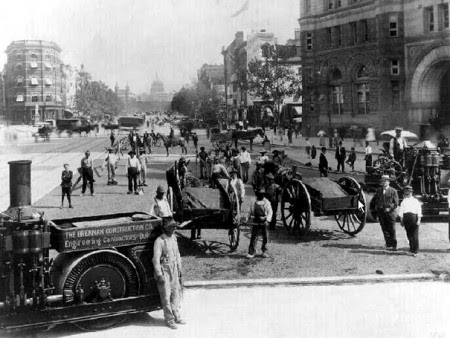July 20, 2022 – Oil & Gas History News, Vol. 3, No. 7
Oil & Gas History News
Welcome to our July newsletter. This month’s petroleum industry milestones include a 1915 petroleum-powered washing machine, the 2008 still record-high oil prices, a Thomas Edison Company film of a New Jersey refinery fire in 1900, and a Kansas town that celebrated its natural gas field in 1887. There’s also Trans-Alaska Pipeline history. And with this summer’s heatwave stressing roads (and airport runways), we feature the history of asphalt. Thanks again for subscribing. Sharing oil history makes a difference.
This Week in Petroleum History Monthly Update
Links to summaries from five weeks of U.S. oil and natural gas history, including new technologies, oilfield discoveries, petroleum products, and pioneers.
July 19, 1915 – Powering Washing Machines and Lawn Mowers
Inventor Howard Snyder applied to patent his engine-powered washing machine that could be fueled by gasoline, kerosene or alcohol. He would assign the rights to the Maytag Company. His appliance for “the ordinary farmer” who lacked access to electricity, used a one-cylinder, two-cycle engine, which would soon be adapted for lawn mowers…MORE
July 11, 2008 – World Oil Price hits Historic High
The price of crude oil reached a record high of $147.27 per barrel before dropping back to $145.08. Oil prices on the New York Mercantile Exchange had peaked at $145.29 a barrel eight days earlier. As supply fears subsided, the price fell below $37 a barrel by early 2009. A decade later, U.S. petroleum consumption ranked number one worldwide, exceeding 20.5 million barrels per day…MORE
July 5, 1900 – Edison films New Jersey Refinery Fire
An early morning lightning strike at Standard Oil Company of New Jersey’s refinery at Bayonne set off explosions and fires in three storage tanks, each with a capacity of 40,000 barrels of oil. Within minutes of the start of the intense but nonfatal blaze, the company’s own fire department and tugboats rushed to fight it…MORE
June 28, 1887 – Kansans celebrate First Natural Gas Jubilee
After erecting flambeau arches at the four corners of the town square, Paola, Kansas, residents hosted, “the first natural gas celebration ever held in the West.” Events included a grand illumination of natural gas street lights, “with the gas attached to a yard sprinkler by a rubber hose, and when it was ignited there appeared nests of small blazes which were beautiful and attractive.”…MORE
June 20, 1977 – Oil begins Flowing in Trans-Alaska Pipeline
The Trans-Alaska Pipeline began carrying oil 800 miles from the North Slope’s Prudhoe Bay to the Port of Valdez at Prince William Sound. The oil arrived 38 days later, culminating the largest privately funded construction project in the world. In 1968, Atlantic Richfield (ARCO) and Exxon discovered the Prudhoe Bay field 250 miles north of the Arctic Circle. Construction of the 48-inch-wide pipeline began in April 1974…MORE
Energy Education
Beginning in 1876, Pennsylvania Avenue was first paved with bitumen imported from Trinidad. Thirty-one years later, a better asphalt made from petroleum repaved the pathway to the Capitol. The nation’s mobility would soon depend on a product from the bottom of the refining process.
Asphalt Paves the Way
As the U.S. centennial neared, President Ulysses S. Grant directed Pennsylvania Avenue be paved with Trinidad asphalt. By 1876, the president’s paving project covered about 54,000 square yards using the imported natural bitumen. The use of asphalt from crude oil refining would prove to be a better alternative, dramatically improving roadways. During World War II, runway surfaces had to handle larger and heavier loads, prompting innovation in asphalt composition and paving technology. Road building would become a huge industry to accommodate the postwar boom.
Learn more in Asphalt Paves the Way
Featured Articles
Many First Oklahoma Oil Wells
Early petroleum exploration began near oil seeps in Indian Territory. The Cherokee Nation in 1884 passed a law authorizing organization of a company, “for the purpose of finding petroleum, or rock oil.” A shallow well completed near Chelsea in 1890 produced oil, but did not achieve the fame of Bartlesville’s Nellie Johnstone No. 1 gusher of 1897.
Learn more in Another First Oklahoma Oil Well
Association of Desk & Derrick Clubs
A women’s petroleum industry association began when a secretary at Humble Oil & Refining Company organized a 1949 meeting in New Orleans. The Association of Desk & Derrick Clubs articles of association were signed on July 23, 1951, by the president of the New Orleans club as well as the presidents of clubs founded in Los Angeles, Houston, and Jackson, Mississippi.
Learn more in Desk and Derrick Educators
Preserving a 1921 Refining Publication
A July addition to the historical society’s Oil & Gas Families page has its own connection with U.S. refining history — and an artifact in search of a home. The Benner family seeks to preserve their grandfather’s 1921 issue of “The Atlantic Connect Rod,” published by Atlantic Refining, which would become ARCO. By 1921, the Philadelphia-based venture opened the nation’s earliest gas stations; Benner was responsible for identifying locations.
Learn more in Preserving a 1921 Atlantic Refining Publication
Visit the AOGHS website often and please encourage your friends to subscribe to this free monthly newsletter. They will be joining a growing number of people who recognize the importance of preserving America’s petroleum history. As supporting membership continues to grow, so does the website’s education network on behalf of community museums. Understanding the nation’s oil history in all of its complexity is important to our energy future.
— Bruce Wells
© 2022 American Oil & Gas Historical Society, 3204 18th Street NW, No. 3, Washington, District of Columbia 20010, United States, (202) 387-6996



